Let’s face it, airline food doesn’t necessarily have the best reputation. For many people, it is thought of as bland, mushy, overcooked, or any one of a plethora of other unappetizing adjectives. Those who actually look forward to airline food are few and far between. While I have personally had some delicious food onboard (I’m looking at you, JetBlue and Virgin America), I have also been served things that rank highly on my list of the worst things I have ever eaten.
When it comes to long-haul flying on international airlines, your prospects for getting a quality meal may improve. Airlines such as Lufthansa consider themselves among the premier airlines in the world, and realize that providing a tasty and nutritious meal is an essential part of the passenger experience.
Recently, I had the chance to meet with a team from Lufthansa and its subsidiary LSG Sky Chefs in New York City to learn about what factors go into making a great onboard meal.
Sky Chefs was founded in 1942 by American Airlines. It provided catering services solely for American until 1986, when it began taking on new customers. Within fifteen years, it became the largest inflight catering company in the world. While this rise was taking place, Lufthansa Service GmbH (LSG) began acquiring chunks of Sky Chefs, beginning with a 25% stake in 1993 and ending with the purchase of all remaining shares in 2001. Today, one out of every four airline meals served worldwide is prepared by LSG Sky Chefs.
Serving high-quality inflight food is a surprisingly complex process. Sure there are the standard food service issues of quality, taste, and presentation. However, there are several other variables that affect food in flight that a normal chef in a restaurant would never have to consider. Altitude, reheating, safety practices, and even the amount of time that the food needs to be held for all provide significant challenges that must be overcome.
Menu items must be designed to be appealing to travelers, while fitting the airline’s quality, operational, and budgetary requirements. Even the time of day when the plane departs can make a difference. On a flight leaving late in the evening, travelers want a light meal before they go to sleep, while on a daytime flight, they want something that is a bit more substantial. Furthermore, what appeals to travelers’ culinary tastes in the air can be quite different from what appeals to them on the ground. For example, very few people keep tomato juice in their fridge at home, and yet Lufthansa serves more tomato juice onboard than beer.
Adding an additional layer of complexity is the diversity of the menu options that are available across Lufthansa’s operation. Each menu is changed every two months, providing frequent travelers with a constantly changing variety of choices. Furthermore, menus vary based on the destination being served. For example, the United States is divided into four regions, each with a different menu at any given time. The quality of the onboard product is very important to Lufthansa. While the airline’s first class product currently holds a five-star rating, the airline’s goal is to achieve that rating for all classes of service.
Let’s start by taking a look at the factors that make serving restaurant-quality food inflight a challenge. By far the biggest hurdle, in terms of taste, is the cabin altitude of the aircraft. While your aircraft is cruising at 40,000 feet, inside the air is pressurized to somewhere between 6,000 feet and 8,000 feet above sea level. While that level of pressurization provides a safe and comfortable air pressure for travelers, without applying undue stress on the airframe, the difference in air pressure between what you feel on the ground and what you experience in the sky is enough to make major changes to how different tastes are perceived.
While some flavors are boosted, others are masked. In fact, taste is the first sense to be affected by a change in altitude. Sour flavors, such as vinegar on a salad or lemon juice, are roughly 30 percent stronger in the air. That is enough to numb your taste buds for the rest of the meal if you used the same amount as on the ground. Lufthansa and LSG Sky Chefs must work with outside suppliers of items such as salad dressings to make sure that the acidity is lowered.
Saltiness reacts in the opposite way, experiencing a decrease of 20 percent on hot items and 30 percent on cold items. Sugar and other sweet tasting substances react in a similar way. The natural instinct of a cook would be to increase the amount of salt and sugar used so that it tastes the way that they want it to. And yet there are serious drawbacks to doing this, particularly when it comes to the health of the person consuming the food. Lufthansa doesn’t take the easy road here, looking instead for alternatives that will enhance those flavors without adding sugar and salt.
In order to improve the flavors of its onboard food offerings, LSG Sky Chefs employs several natural flavor enhancers. These substances, taken from lemons, oranges, and tomatoes, boost the flavor of food without adding sugar or salt. The catering company also puts a strong emphasis on bold flavors, while using its decades of experience to avoid ingredients, such as dried herbs, that experience strong flavor changes in flight.
In fact, Lufthansa specifically requires that its food only contain fresh herbs. Speaking of herbs, many also taste quite different on the palate of an airline passenger. Some, such as rosemary, take on a flavor of hay, so they are not used. Meanwhile, herbs such as basil, chives, and parsley release less flavor under the lower air pressures experienced in flight. Those flavors are added in towards the end of the cooking process, and the amount that is used is doubled.
There are also several challenges that arise when it comes to preparation of the food. Each meal that is prepared must be appropriately cooked before the flight, chilled to a safe temperature until just before it is served, and then reheated onboard the aircraft. For some entrees, such as steak, this is less of an issue. Steaks are cooked to somewhere between rare and medium-rare on the ground.
Once in flight, the reheating process finishes the cooking of the meat, with the goal being for the steak to be medium to medium-well cooked. This is why that ’œperfect medium-rare’ steak is so elusive in flight. Items like chicken, however, are more tricky. Standard food safety practices dictate that chicken must be cooked to 160 degrees before it leaves the kitchen. However at that temperature, the chicken is already considered to be fully cooked. Reheating onboard must be done carefully, in order to not dry out the chicken or overcook it.
So how does the team at Lufthansa design the perfect inflight meal? For obvious reasons, the airline places a strong focus on the first and business class cabins, where passengers expect a high quality product in exchange for the premium price that they pay. In first and business class, menus are designed by outside chefs working with the airline to create a menu.
For the first class meals, Lufthansa relies on a team of three world-class chefs. Each of them have been given three stars by Michelin (their highest ranking). For business class, the airline often chooses a celebrity chef to design the food selections, though certain seasons (such as Oktoberfest) do not require this. While this is not typically a paid assignment, arrangements are made with each chef to assist in promoting them and their restaurants in various ways.
The design process consists of several steps, with the outside chefs working alongside the team at LSG Sky Chefs. The first step is for the chef to create their menu, working within the criteria provided by Lufthansa. While the chefs are typically given a large amount of freedom in terms of what they would like to offer at this stage, occasionally there are specific items that the airline asks them to create. These specific requests often come from either passenger comments or focus groups that Lufthansa hosts to refine their onboard product.
Once the menu has been designed, representatives from LSG Sky Chefs visit the chef in their own kitchen. There, they learn how to properly prepare each item on the menu by working alongside the chef. Next, the team at LSG Sky Chefs works to replicate each item on the menu, while working within the confines of what it takes to get a meal into the air. Food is taste tested inside of a pressure chamber to simulate the taste at altitude.
Once the team at LSG Sky Chefs thinks that they have gotten it right, the chef who designed the meal is brought in to make sure that it fits their standards. If it doesn’t, the process is repeated, refining until all parties are satisfied with the finished product.
Serving the meals onboard can be a challenge in and of itself. Economy class is the easiest: foil trays are warmed to serving temperature, before being added to the meal tray with the other cold items that are being served. The premium cabins, however, take a bit more work.
Passengers in both first and business class have their meals served on china, though how it gets on the plate varies. Entrees in first class are delivered to the aircraft in three compartment foil trays, which are used to store and heat the meal. The sauce for each meal is separately contained in its own foil cup, allowing easy pouring. After heating, the flight attendants are responsible for properly plating the meals.
While all flight attendants must receive specialized training before they are allowed to serve the first class cabin, there is no land-based training for how to plate each specific meal. Instead, each flight has step-by-step instructions for how each dish should be presented. These instructions include large, detailed photographs of each step of the preparation.
Meanwhile, in business class each entree arrives on the aircraft pre-plated and wrapped in plastic. In flight, the wrapping is removed and the entire plate is reheated. If there is a sauce for the meal, it is sent and reheated in a separate container, before being added to the entree by the flight attendants. Other items to be served in both first and business class, typically those that will be served cold, also arrive at the aircraft pre-plated.
Since presentation is a priority, special care must be taken in the design of any pre-plated dishes to ensure that they can withstand the forces of flight, particularly takeoff and turbulence. These motions have the potential to shift the contents of a plate into an undesired position.
To accomplish this, LSG Sky Chefs has a couple of tricks up its sleeve. For some menu options, plates with subtle shaping characteristics can be used to physically contain the food in the desired area. For example, a dish might have a wide rim and a shallow well in the middle. What comes across as a trendy presentation is actually a crafty containment method. Other foods, particularly those that are served cold, may have a sauce or other accompaniment that can act as a sort of glue to hold everything in place. These two techniques, combined with plastic wrap, can help to ensure that food looks as good on the tray table as it does in the catering facility.
With all of the thought that goes into Lufthansa’s meal selection and preparation, there is one important piece missing: How does it taste? I had a chance to sample several of Lufthansa’s first and business class menu offerings, and the results were delicious. We started off with an amuse bouche, or bite-sized hors d’oeuvre, of Firecracker Shrimp.
It was a small plate with a single perfectly cooked and chilled shrimp, served atop a thin, guacamole-type dressing that made me want to lick the plate clean. This was an example of a cold, pre-plated dish that could withstand the forces of flight. We watched as one of our hosts tilted the entire small plate on an angle, with the design of the plate and the consistency of the sauce combining to keep the shrimp perfectly centered. That was followed up by the appetizer, mixed greens wrapped in a slice of pan-seared beef filet.
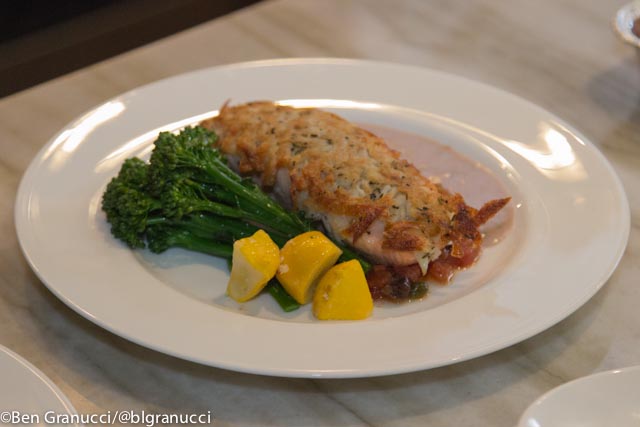
Yukon Gold crusted salmon with fresh vegetables, served over a bed of diced tomatoes and black beans.
Next came a conga line of entree options. Each menu option was prepared just as the team from LSG Sky Chefs would prepare them before a flight with nothing added or removed from the recipe. The selections highlighted how the use of herbs and other bold flavors could make meals taste delicious, without them being overly salty or sweet. The chicken was very moist and was served over a quinoa salad. The pasta selection was the vegetarian entree, a perfectly prepared cheese ravioli with butternut squash sauce and mixed vegetables.
Next up were the crab cakes that were served over succotash and accompanied by grilled mixed vegetables. Finally, we were served what was probably the most intriguing dish to be shown that day: a Yukon Gold encrusted salmon served over a bed of diced tomatoes and black beans. Fish can be a tricky dish to serve onboard an airplane. Once it is heated, the smell can permeate the entire cabin. By creating a potato crust not only is a lot of flavor added, it also encapsulates the odor. Each of these menu options were quite delicious, on par with what I would expect at a nice restaurant. Flavors were strong, yet nowhere near overpowering. Each dish was well-rounded, with plenty of vegetables joining the proteins.
Lufthansa does not just go through all of this trouble for its regular menu selections. They also pay great attention to the childrens’ meals onboard. The airline holds focus groups with kids a couple times per year in Germany, where actual menu items can be taste-tested by the palates of children to make sure the items are kid-approved. These focus groups are also useful for seeing which foods kids would like to eat.
Just because kids want to eat it on the airplane doesn’t mean that they can, of course. The banana is one of the most requested food items by children, and yet it is impossible to cater on an airplane. The problem here is that all perishable food that is to be served onboard must be refrigerated. And if you have ever put a banana in the refrigerator, you know what happens. The banana turns brown both inside and out, leaving it unappetizing to all children and most adults. So anybody who wants a banana onboard will have to wait until they are back on the ground.
Another tricky menu item that is often requested is the good-old American cheeseburger. Here there are several considerations that make things difficult. First, the meat must be warmed while it remains juicy inside. As anybody who has ever reheated a hamburger knows, this can be tricky. The bun should be warm and toasty, though keeping the patty on it will make it soggy. Therefore, the two pieces must be heated separately. Meanwhile, all of the toppings must be kept cool. However, Lufthansa assured us that creating the perfect in flight cheeseburger is a priority for them, and that it is an ongoing project that they just have not found the perfect solution for yet.
It is truly incredible just how much effort Lufthansa puts into creating their onboard meals. They have shown that they truly care about the onboard dining experience of their passengers. It is easy to provide mediocre food that doesn’t taste good, or to load food up with extra sugar and salt to try to make it taste better. To make food taste great without taking these shortcuts is much more difficult. Lufthansa has proven that the extra effort required is well worth it for both its passengers and its brand.
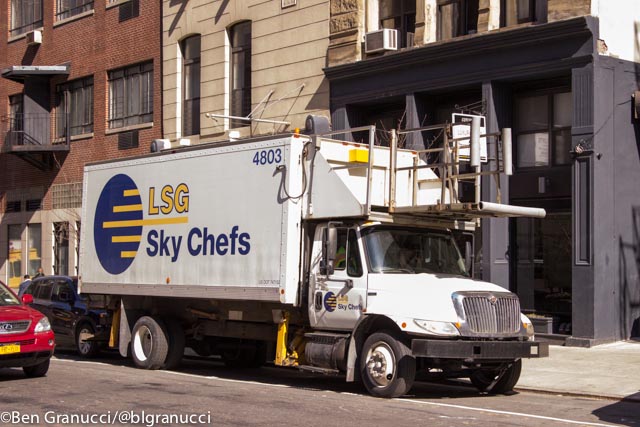
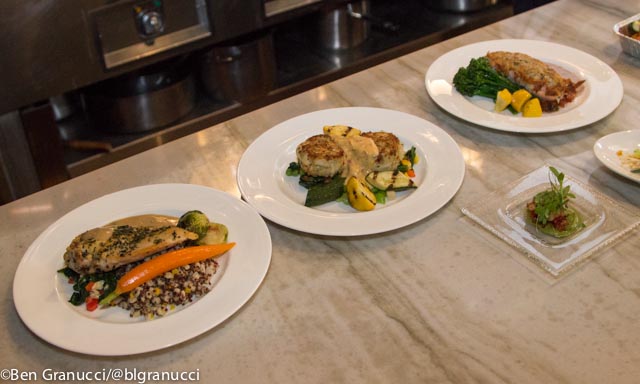
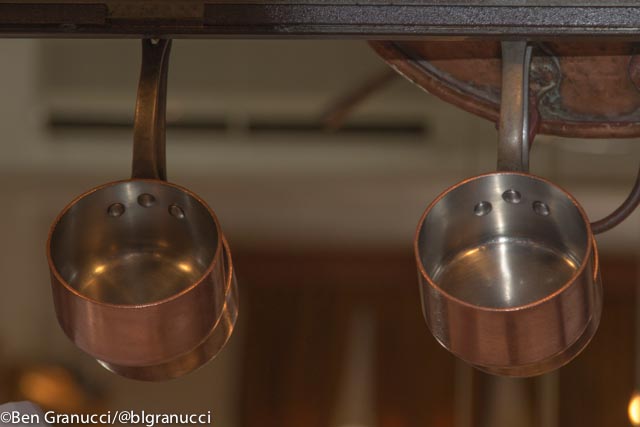
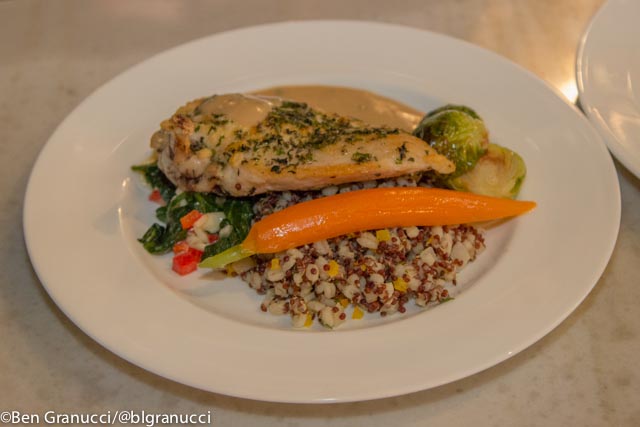
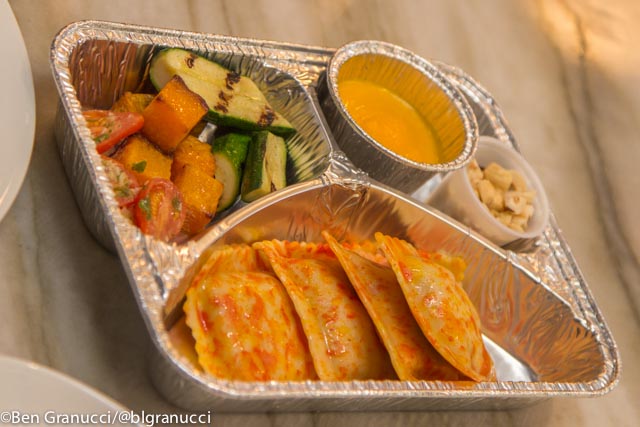
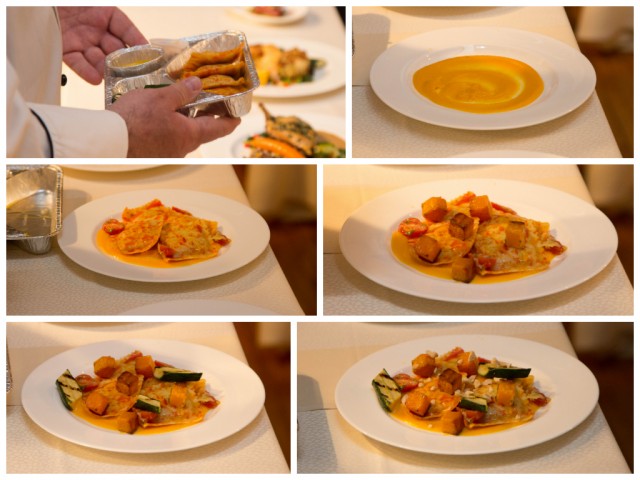
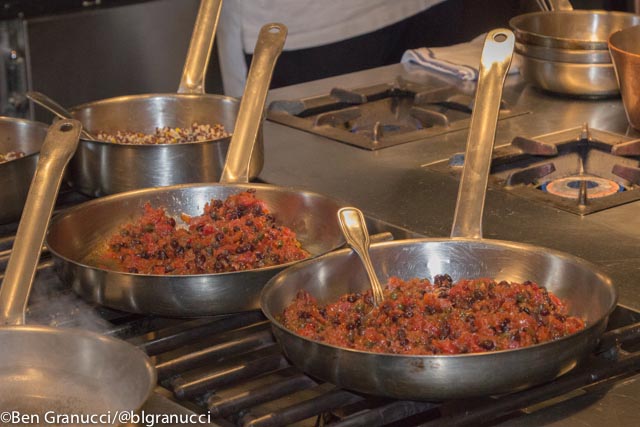
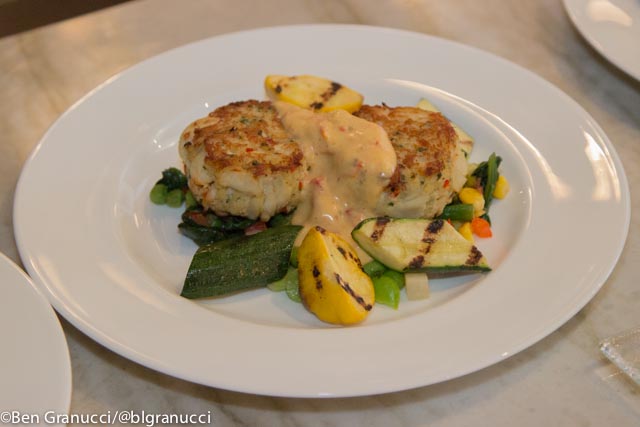
Since changes in altitude affect one’s taste buds (which I would not have guessed, by the way), is a low-pressure tasting chamber used for taste testing, or do the developers know enough about how flavors are altered to be able to extrapolate from normal eating conditions?
Hi Nathan:
Yes they do use a pressure chamber (or in this case a depressurized chamber) for taste testing at least some of the menu items that they are developing.
Love this piece. I had heard that the altitude change affects taste but had no idea that it was so nuanced. Also news to me that the Sky Chefs are owned by Lufty. Excellent work, Ben and thanks for the education. Sorry you had to endure all of that amazing food for us 😉
Thanks JL! Its a dirty job, but somebody’s gotta do it! 🙂
Yes, we have no bananas! Very informative article and I know an S/O who will be very interested in reading about your experience. The menu creation departments certainly have a lot on their plate (pun intended) in considering the complex factors involved in in-flight catering.
Ha! If anyone thinks that First Class airline food, as delivered by U.S. carriers is sub-standard, I suggest that you try a 2.5 – 3.0 day ride on a long-haul Amtrak train! Amtraks’s train carry fewer First Class PAX than most jumbo jets, have larger tables and far larger, better equipped galleys, yet are seriously pressed to produce a decent meal. When asked, their on-board Service Managers acknowledge the presence of on-board cooking facilities, but lamely attempt to explain that reheating packaged goods is more ‘cost effective’ than is cooking, *even for breakfast*. There is more…
On an airplane, a first class passenger requesting a beverage, soft, hard, hot or cold is served so quickly that the attendants seem to trip over each other. On a First Class *Long Haul* train, the crew will driect the PAX to the mid0car coffee pot and tell them to help themselves. Want a soft drink, “Please visit our snack bar in the XYZ car,” and be prepared to pay about $1.50 for a standard can – no ice and no cup.
Oh yes, meals are included in your fare! During the limited meal service hours, be prepared to be crammed in, four to a table for two, friends and strangers alike, close enough to identify their deoderant brand – IF any is used. you are also encouraged to eat as quickly as possible as others are waiting. Amtrak advertises “In Compartment Dinning upon request,” but it has always been refused. I’ve tried scheduling my meal appointment at the beginning of service and at the tail end, specifically explaining that because of a substantial hearing loss, I prefer to dine either alone or with my partner; casual conversation with others is virtually impossible. “Oh, of course, sir! will you come when we open at xxxx time?” I show up early, get crammed into the tiny booth with the others and the dinning car host says that he’s never heard of our request. OK, please implement it for the next meal. It NEVER happens.
Bitch all you like about “Airplane Food,” but you rarely have to eat more than one meal. IF you truly want to suffer, book a long-haul, trans-con trip (First Class) with Amtrak and learn just how horribly you can be abused. Yes, I mean buying your own soda. If one is truly infirm and not able to migrate to the dinning car, you may well starve!
While end-of-trip tipping is the industry norm, Amtrak’s car attendants make their calculations and service plans during their FIRST visit through the car. Be prepared to pay up front, nothing short of 25% will move them, and it is still a gamble. You won’t prevail the the dinning car staff no matter how much you pay: Their sole objective is to turn the tables, get you OUT so that they can relax until the next meal. Any table occupancy beyond fifteen minutes is an Major Inconvenience to them and they want you OUT. Enjoying the sunny morning’s scenery with your Railroad French Toast (Horrible) or an extra cup of coffee, is a major imposition and one that even an substantial advance tip won’t help you through. They don’t give a [fill-in] and they want you OUT as fast as you can stuff your face.
This evaluation is not based on one trip, but multiple trips. they simply do not care. If you are faced with a car or train change in the middle of the night, say in Spokane as 0230, be prepared to move on your own; Amtrak staff will NOT grant any assistance, even if you politely ask ahead of time. And, despite excellent facilities in their dinning cars, they use only the warming ovens. The only reasonable choice for an evening meal is a braised dish, something that a long holding time cannot usually damage. Take your own beverages, even sodas, and scratch you head to raw wondering why they have the nerve to call this “First Class.” The Movie Rooms do not work, half of the rest rooms are often out of service and the attendants do not respond to signals beyond apologizing that ‘that service is not available on this train ( and has not been for many months). No! I’ve given them more than enough chances. Amtrak has NEVER delivered what they advertise and I’m done with them. Done for all time!
Flying is better and, when possible, driving is better yet.
-C.
(If Amtrak cares to respond, please do so here and we’ll connect through David’s blog. David: Go for it and please share my address with a legitimate Amtrak representative. I’ll update if there is anything to report.)
Hi,
I fly Lufthansa quite often, as I am from the US and live in Europe, I have flown them in domestic europe economy, business and international economy and business. I will say this carefully, I have never, ever, had a good meal on Lufthansa, period. There food selection sucks, even their employees( I have a friend who is a senior vp working on employee training in Frankfurt) agree that they have a long ways to go to catch up to the worst american airline, and that is saying something, while I think this article is very informative, and very well written, it is a marketing ploy on behalf of Lufthansa, as none of this food reaches the passengers, rather you end up with inedible combinations of mish-mash across the board. For example IAD-Frankfurt flight in Business, in the past year, they were serving a chicken florentine dish that was quite putrid, and accompanying it was a weird 1950’s era Jello with fruit inside, and on the connecting flight to berlin, they served a meat platter with the same jello and cheese. mind you, Lufthansa has relatively great customer service, and is very well run, but food is certainly not their strong point, I would take a meal on United Economy over Lufthansa business almost any day, but if this article hints that they aim to improve their food, then i am all for it, but until that happens, I believe this article paints an idealized image of Lufthansa’s in-air food
Heck yes! I must agree with 95% of Matt’s above note. Some thoughts…
LH’s cabin service, is ALL classes is exceptionally good. Let’s don’t for get that. The the food itself, in all classes, including their otherwise famous First Class, is usually horrible. (I feel for the dedicated FAs forced to serve substandard food to their most important clients.
The cabin service executives are not fools and I do not believe that they are missing anything. They purposfuly offer less and hope that they can get away with it, most of the time. Is that any way to run a First Class cabin – and at the prices that LH demands? No.
The leading post was a casual thing, but as a frequent Atlantic x-er, it caught my attention. The ‘over-pond’ competition is substantial. U.S. carriers provide reliable flights, but their on-board service is left of horrible. European carriers have better records, including faaaar better food and service standards, but will cancel and book you elsewhere in a flash. Take your choice. I don’t know the right answer, winter or summer. Some degree of loyalty to LH may beneficial, but don’t bank on it. Unless you are paying the last minute “F Class” fare, perhaps $15K, do not expect much special accommodation once you are off the airplane. In the end, LH and most other carriers will accommodate nearly anything to get you into that spendy seat and then serve you with seriously impressive grace. Once the airplane lands, you are on your own’ they are terribly sorry, but their service ends when you leave the airplane. Got a return ticket in F? Talk to us about that flight. This one is done, your person is now delivered and — Go Away. Got an “F” class ticket for another flight or your return, we’ll talk. This flight has landed and we are done with you.
Perhaps an overstatement, this IS the norm for LH and most others. A few Asian carriers provide supportive services to arriving pax, but not many. LH, the other European majors and the close friends offer little – typically nothing – to arriving Pax, including quick customs and immigration clearance.
Check the details, get the facts and validate some of them before spending the bucks for F or J seat transportation. Sometimes it is great and other times it is horrible.
What you’re saying here is there’s a good opportunity for somebody to invent a spray that won’t let bananas brown while they’re in the fridge? Wonder what the Sharks would think of that?
Fascinating story!
Mike H.
I once had a banana served as part of a pre-arrival meal in Y on DL from DTW-AMS in 2010. It wasn’t good though (I suspect that contributed to 3 pukers on arrival at AMS). I wanted to join in the puking chorus but held back because I had a connecting AMS-KUL flight.